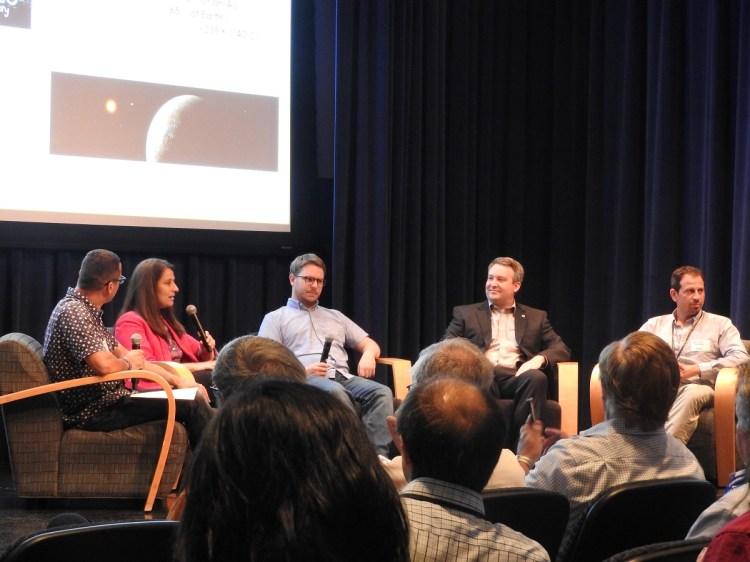The world of astronomy lit up in the past couple of days with a report that Russian astronomers may have received a signal from a distant star.

Above: Bill Diamond, president and CEO of SETI Institute.
At a panel discussion today hosted by SETI Institute (named for the Search for Extra-Terrestrial Intelligence), the excitement around the possible discovery was palpable in the crowded audience. But there’s plenty to be cautious about for now, according to a blog post by astronomer Franck Marchis, as well as SETI officials at the event.
Bill Diamond, president and CEO of SETI, said after the panel discussion, “Nothing would make us more excited than to verify it. But we have to observe it and look at the data.”
He said that SETI has pointed the Allen Telescope Array at the host star, dubbed HD 164595, which is 94 light years array. So far, the array has not detected anything from the star. The Russian scientists said they detected the signal in May 2015, but they failed to alert the international astronomy community about the detection of the mysterious signal. And that hinders the ability to clarify what caused the signal, Marchis wrote. The antenna may very well have captured a “parasite” signal, or one that came from a satellite or an airplane.
The star system has a Neptune-like planet that orbits very close to its star every 40 days. Marchis said no one has detected an Earth-like planet around that star, and they do not believe there is one.
“Finally, before getting too excited about a speculative and relatively old signal, we should recall the puzzle of the perytons,” Marchis wrote. “Astronomers detected them at the Parkes Observatory in Australia in 2015, only to later conclude that they were nothing more than the signal from a nearby microwave oven whose door was opened by impatient astronomers.”
If the signal is detected and verified, then, Marchis said, “We can analyze it under the assumption that it might have content E.T. wants to share with us. Whatever that message might be — the digits of Pi, the first prime number, their encyclopedia, or some images of themselves — we can quickly find out if ET is trying to tell us something, and what that something is.”

Above: The planet Proxima b orbiting the red dwarf star Proxima Centauri, the closest star to our Solar System, is seen in an undated artist’s impression released by the European Southern Observatory, distributed August 24, 2016. ESO/M. Kornmesser/Handout via Reuters
Jill Tarter, former head of SETI and an astronomer, also said in an interview with VentureBeat that the Russian signal alert didn’t follow established protocol and is worrisome because it has not been repeated.
There is, however, plenty to get excited about when it comes to the study of exoplanets, or planets that are within a habitable range of a star. With the launch of the Kepler space telescope in 2009, exoplanet discoveries have multiplied dramatically. Nearly 4,000 exoplanets have been identified.
SETI’s event at the Microsoft campus in Mountain View, California, was about the recent discovery of an exoplanet in the orbit of Proxima Centauri, our closest stellar neighbor. At 1.295 parsecs, the planet is just four light years away. Tarter said this announcement was very exciting.
But the planet has harsh conditions for life as we know it. It has a rotation period of 83 days. It is also pounded by X-rays and frequent solar flares. The star has just 12 percent the mass of the sun. But its equilibrium temperature is within the range where water could be in liquid form on the surface.
Guillem Anglada-Escude, a lecturer at the Queen Mary University of London, said during the SETI panel that the mass of the planet is about 1.3 times that of Earth, as detected by the latest Doppler spectroscopy results.
“I don’t want to oversell the speculative conclusions that can be derived from this,” Anglada-Escude said. “I hope people will get more motivated.”
Marchis said he was very excited about the Proxima Centauri discovery, and he added, “The view of astronomy is changing a lot with this discovery.”
As far as her reaction to the Proxima Centauri finding goes, NASA Ames astronomer Natalie Batalha said on the panel that her first reaction was skepticism and her second was intense wonder and excitement upon verifying the data. She foresees a 30-year roadmap on the quest to find new life in the galaxy.
“What Kepler has taught us is the nearest habitable planet is potentially within 10 light years,” Batalha said. “Only seven stars are in that range. We are lucky.”
As for the Russian radio signal, however, she said, “No one else has seen it.”
Still, Tom Barclay, a NASA senior research scientist, said on the panel, “The next 30 years are an age of discovery.”
VentureBeat's mission is to be a digital town square for technical decision-makers to gain knowledge about transformative enterprise technology and transact. Learn More

